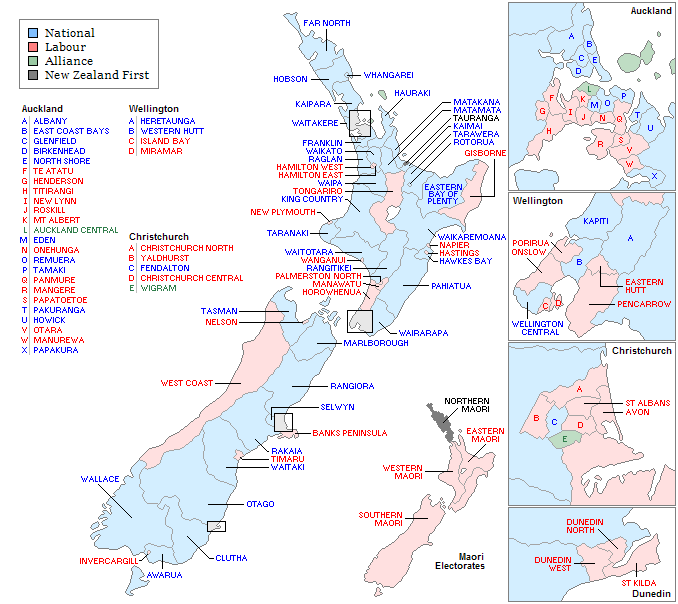44th New Zealand Parliament
| Terms of the New Zealand Parliament  |
| 1st | 2nd | 3rd | 4th | 5th 6th | 7th | 8th | 9th | 10th 11th | 12th | 13th | 14th | 15th 16th | 17th | 18th | 19th | 20th 21st | 22nd | 23rd | 24th | 25th 26th | 27th | 28th | 29th | 30th 31st | 32nd | 33rd | 34th | 35th 36th | 37th | 38th | 39th | 40th 41st | 42nd | 43rd | 44th | 45th 46th | 47th | 48th | 49th | 50th 51st |
The 44th New Zealand Parliament was a term of the Parliament of New Zealand. Its composition was determined by the 1993 elections, and it sat until the 1996 elections.
The 44th Parliament was the last to be elected under the old FPP electoral system, with voters approving a change to MMP at the same time as they voted in the 1993 elections. As such, the 44th Parliament saw a considerable amount of positioning for the change — at the beginning of the term, there were four parties in Parliament, but at the end, there were seven parties and one independent. The National Party, which had begun the term with a majority, was forced by the end of the term to form a coalition to remain in power. Despite the various maneuverings, however, the National Party remained in government for the duration of the 44th Parliament, which comprised National's second term in office. The other three parties present at the start of the 44th Parliament, being the Labour Party, the Alliance, and New Zealand First, all remained in opposition.
The 44th Parliament consisted of ninety-nine representatives, two more than the previous Parliament. All of these representatives were chosen by single-member geographical electorates, including four special Māori electorates.
Electoral boundaries for the 44th Parliament

Initial composition of the 44th Parliament
The table below shows the results of the 1993 general election by electorate:[1]
Key
National Labour Alliance NZ First
Table footnotes:
- ↑ Hamish MacIntyre left National in 1992, joining the Liberal Party which became part of the Alliance
- ↑ Gilbert Myles left National in 1991, becoming Independent, then joining the Liberal Party, which became part of the Alliance, finally New Zealand First in 1992–93
- ↑ Winston Peters had been an Independent since the 1993 by-election.
- ↑ Albiston was first on election night for Waitaki, but lost when special votes were included
By-elections during 44th Parliament
There was one by-election held during the term of the 44th Parliament.
| Electorate and by-election | Date | Incumbent | Cause | Winner | ||||
|---|---|---|---|---|---|---|---|---|
| Selwyn | 1994 | 13 August | Ruth Richardson | Resignation | David Carter | |||
Summary of changes during term
- Ruth Richardson, the National Party MP for Selwyn, quit Parliament in August 1994, having been replaced as Minister of Finance the previous year. Her departure prompted a by-election in Selwyn, which was won by David Carter of the National Party.
- Peter Dunne, the Labour Party MP for Onslow, left his party in October 1994, believing that Labour was becoming increasingly left-wing. He was an independent for a time before founding the small Future New Zealand party. He would later join with United (see below).
- Ross Meurant, the National Party MP for Hobson, left his party in September 1994, having clashed on a number of issues with the party's leadership. He eventually established the Right of Centre party.
- Graeme Lee, the National Party MP for Matakana, left his party in 1994, partly due to policy disputes with its leadership and partly due to having lost his Cabinet post in a reshuffle. He founded a new party which eventually became the Christian Democrat Party.
- Trevor Rogers, the National Party MP for Howick, left his party in June 1995, after disputes regarding policy issues with the party's leadership. He joined Ross Meurant's new party.
- A group of centrist MPs from both the National Party and the Labour Party, along with Peter Dunne and his Future New Zealand party, established a centrist party named United New Zealand in June 1995. The MPs who founded United were Margaret Austin, Bruce Cliffe, Peter Dunne, Clive Matthewson, Pauline Gardiner, Peter Hilt, and John Robertson.
- Ross Meurant, founder of Right of Centre, came into conflict with his own party (now renamed the Conservatives) in February 1996, and left the party to become an independent again. Trevor Rogers, the sole remaining MP, became leader.
- Jack Elder, the Labour Party MP for Henderson, Peter McCardle, the National Party MP for Heretaunga, and Michael Laws, the National Party MP for Hawke's Bay, all left their parties to join New Zealand First in April 1996.
- Michael Laws, the New Zealand First (originally National) MP for Hawkes Bay, resigned from Parliament after the so-called "Antoinette Beck" controversy. Rather than hold a by-election, the Prime Minister simply brought the 1996 general election forward slightly, as the rules allow that if a general election is approaching, a vacant seat need not be filled immediately.
Notes
- ↑ "New Zealand Elections 1972-1993". New Zealand Election Study. Retrieved 17 December 2011.
References
- Temple, Philip. Temple’s Guide to the 44th New Zealand Parliament. Dunedin: McIndoe Publishers. ISBN 0 86868 159 8.
- Part 1: Votes recorded at each polling place (Technical report). Chief Electoral Office. 1993.